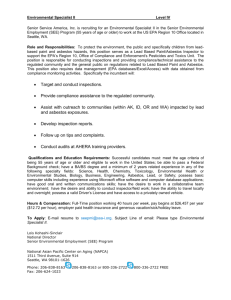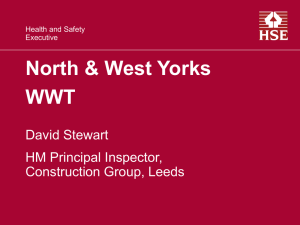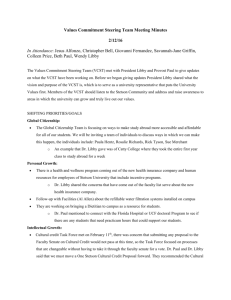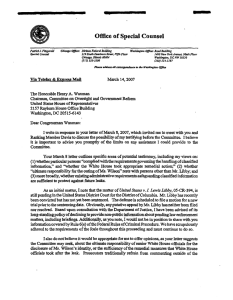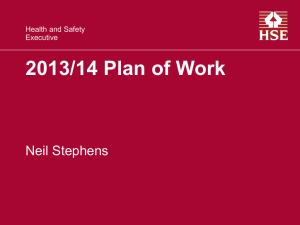Libby Community Advisory Group Meeting Summary June 15, 2006 Introductions
advertisement
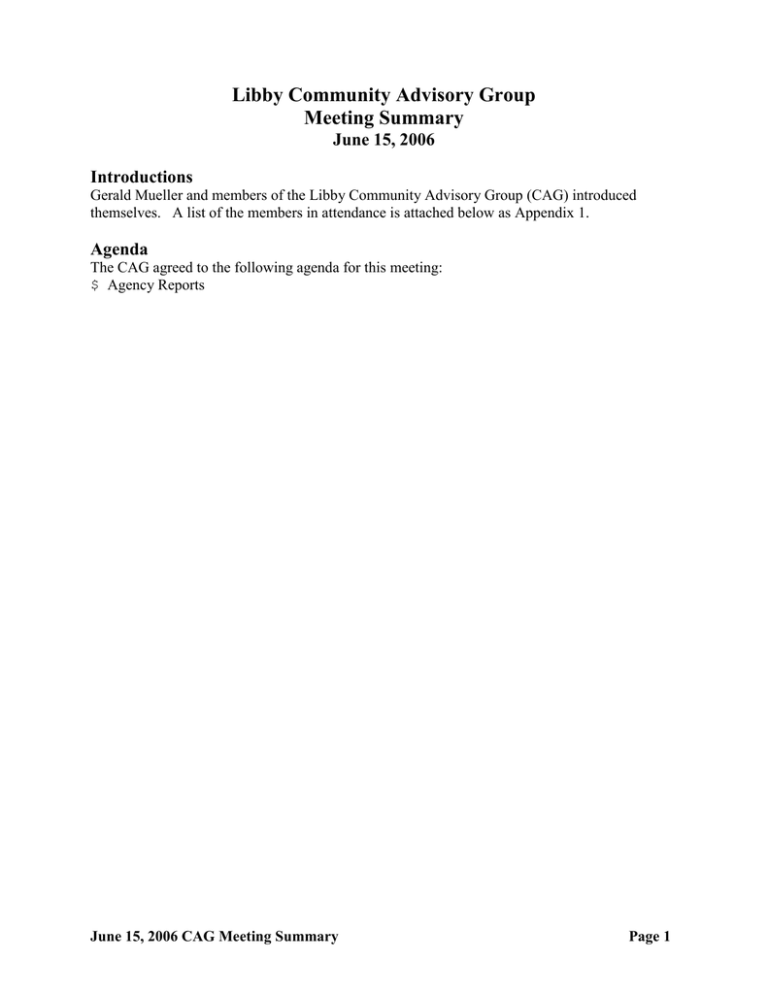
Libby Community Advisory Group Meeting Summary June 15, 2006 Introductions Gerald Mueller and members of the Libby Community Advisory Group (CAG) introduced themselves. A list of the members in attendance is attached below as Appendix 1. Agenda The CAG agreed to the following agenda for this meeting: $ Agency Reports June 15, 2006 CAG Meeting Summary Page 1 Review Draft - Not for Quotation S EPA S State DEQ DOT DPHHS S TAG S CARD June 15, 2006 CAG Meeting Summary Page 2 Review Draft - Not for Quotation Public Comment EPA Report Peggy Churchill reported for EPA on the following topics. Cleanups - During this year, 68 properties have been cleaned. The cumulative total cleaned to date is 675 properties. Troy High School - Cleanup at the high school will begin at the end of June. Export Plan Property - When the City of Libby was digging a trench for a water line on the former WR Grace export plant site, it discovered material contaminated with asbestos. The City halted construction activity. The City and EPA then developed a plan for continuing the work, which included lining the Trench with plastic and placing sand at the bottom of the trench. Wearing protective gear, City workers then went into the trench to finish the work on the water line. The water line has now been connected to the fire hydrant system. EPA will work with the City to finish the remainder of the trenching. EPA will also conduct additional site characterization and discuss with the City its future plans for this site. EPA July Visit - In July, an EPA technical team will visit Libby to discuss the conceptual model of the asbestos exposure pathways. EPA will take public comment on the model. Dream It - Do It Seminar - EPA’s third Libby Dream It - Do It Seminar economic development seminar will be held on August 14 and 15. It will focus on redevelopment of the industrial park and other areas in the city. Senator Burns and Congressman Rehberg are scheduled to participate in the seminar. Audience Member Question - In May of 2001, Libby City Attorney Scott Spencer wrote a letter to Paul Peronard detailing how W.R. Grace was to install the water line on the export plant site. In October 2002, a UAO was signed stating that W.R. Grace was to install the water line. Why did the City end up installing the line? Answer - I don’t know why, except to say that the site is City property. Audience Member Question - How did W.R. Grace get out if the requirement to install the line? Answer - I have not seen the administrative record with the requirement to which you are referring. I will ask Paul Peronard about it. June 15, 2006 CAG Meeting Summary Page 3 Review Draft - Not for Quotation Audience Member Question - Who was the City contact for the UAO? Answer - I don’t know, but I will find out. Audience Member Comment - I attempted to ask my question at the EPA’s meeting with the Mayor, but I was not permitted to attend. Response - The EPA meeting with the Mayor was not secret. The Mayor, and not EPA, barred you and City Council members from attending. You will have to take your exclusion with the Mayor. Audience Member Comment - EPA’s credibility is damaged when it participates in closed negotiating meetings. CAG Member Comment - Prior to the City’s digging at the export plant site, the general public had a perception that all contaminated material had been removed from this site. The discovery of the contaminated material calls into question future uses of the export plant property. Response - This event provides an opportunity to explain that contamination has been left at depth. EPA and W.R. Grace did do what they were supposed to do at this site according to the cleanup work plan. The standard protocol is to remove material to a depth of eighteen inches and cover with clean fill or top soil. At this site, EPA did not remove material to a greater depth than eighteen inches unless we found gross contamination at a greater depth. CAG Member Question - Who bears the cost of cleanup when contamination is later found below an area previously cleaned? Answer - EPA will work with the Operation and Management Work Group and the public to address this issue. The Work Group includes representatives of EPA, the state, the county, and the city. CAG Member Comment - This issue will come again because we need to pour footings for the pavilion. State Report June 15, 2006 CAG Meeting Summary Page 4 Review Draft - Not for Quotation DEQ - Catherine LeCours, with the Montana Department of Environmental Quality, did not have a report, but took questions. June 15, 2006 CAG Meeting Summary Page 5 Review Draft - Not for Quotation Audience Member Question - Who represents the citizens of Libby in the civil and criminal court proceedings? Answer - DEQ does not. I will find out. MDT - Brian Goodman reported on behalf of the Montana Department of Transportation (MDT) about his department’s future maintenance procedures and environmental investigations planned in the Libby area. Mr. Goodman is a staff member of the Environmental Services Bureau. With him was Van Swearingen, the local MDT Maintenance Section Supervisor. MDT has instituted a moratorium on maintenance of Highway 37 from the Kootenai River Bridge to Rainy Creek Road until it has evaluated the situation regarding asbestos contamination. MDT will sample all state road rights of way for asbestos within a five mile radius of Libby. It has conducted an asbestos training session for its personal concerning protection procedures when maintenance would disturb soils. MDT has retained a consulting firm, Maximum Technologies, to sample Highway 2, Highway 37, Farm to Market Road, Pipe Creek Road, and River Road as well as the state and private gravel pits in the vicinity of Libby for asbestos contamination. Road sweeping collected by MDT sweepers will also be sampled. Maxim Technologies will report their findings to the state and the public. This sampling is being funded by the state, not by not EPA or other federal agency. Audience Member Question - Will MDT sampling use EPA analytical techniques? June 15, 2006 CAG Meeting Summary Page 6 Review Draft - Not for Quotation Answer - Yes. We will use the same sampling protocols and the same firm, EMSL, to do the analysis. Because of its work load, we cannot use the same EMSL lab as does EPA for Libby. We will use another EMSL lab. We expect to have a report by September 2006. Audience Member Question - Will the state be seeking reimbursement for its sampling costs from the federal government? Answer - We have not discussed reimbursement. CAG Member Question - How much will the sampling cost? Answer - About $100,000 for the first phase. Audience Member Question - Do you know the source of the contamination? Answer - No. We understand that haul traffic from the mine may have been a source. Audience Member Comment - The road was rebuilt in 1996 with uncontaminated material. I believe that the contamination resulted from 35,000 truck loads of contaminated material that EPA has hauled from the town to the mine. CAG Member Comment - During the road reconstruction, drilling found plumes of contamination in the rock faces along Highway 37 from Libby to Eureka. Response - Our sampling in 1996 of construction aggregate materials did not analyze for asbestos. Our primary concern remains the safety of workers. The source of the materials used during the 1996 reconstruction of Highway 37 is of secondary concern. Audience Member Comment - Many people use the highway for recreation, including horseback riding. People also pick up litter. June 15, 2006 CAG Meeting Summary Page 7 Response - We understand that the road has been determined to be safe for pedestrians. However, MDT is not in the risk assessment business. We will leave to EPA assessing potential exposure pathways. June 15, 2006 CAG Meeting Summary Page 8 Review Draft - Not for Quotation Response by Peggy Churchill - EPA conducted scenario sampling along the road right of way and found that the contamination concentration in terms of polarized contrast microscopy equivalent of Libby amphibole fibers was less than the Occupational Safety and Health Administration permissible exposure limit. June 15, 2006 CAG Meeting Summary Page 9 DPHHS - Chris Korhonen, an epidemiologist with the Montana Department of Health and Human Services (DPHHS) Environmental Tracking Program reported on behalf of her department. She stated that this past February, DPHHS mailed a letter to people who had been screened by the Montana Asbestos Screening and Surveillance Activity (MASSA). The letter welcomed new clients to the program, discussed the resources available and the importance of regular, consistent screening, and introduced the MASSA staff. MASSA will shortly be mailing a second letter to people who have been screened reminding them of their need for follow-up screening to check for changes in their lungs related to asbestos exposure in Libby. Ms. Korhonen passed around copies of the materials for the mailing. A copy of these materials is included below in Appendix 2. TAG Report Gayla Benefield and Helen Clarke reported on behalf of Technical Advisory Group (TAG). Ms. Benefield noted the presence of Dr. Gerry Henningsen in the audience. She stated that while there has been recent controversy regarding its authority and responsibility, the TAG continues to do its work. The TAG will be reporting about medical and cleanup related science to the community and will be challenging EPA when necessary. It will be seeking consensus with the EPA about testing and the contamination to be left after the cleanup is completed. The TAG plans bimonthly notices in the newspaper addressing topics such as the testing and the cleanup record of decision. Helen Clarke then made a PowerPoint presentation regarding the possible hiring by the City of Libby of an Environmental Resource Specialist (ERS). The purpose of the position would be to provide education to Libby residents and business owners to assist them with dealing with issues related to Libby Amphibole asbestos and vermiculite. She noted that EPA, the state, and several Libby organizations support hiring someone for this purpose, but she is unsure about the county’s position. The TAG is seeking a memorandum of understanding regarding the ERS with the county. Ms. Clarke listed the general duties of the ERS, described the training, equipment, and fiscal requirements for the position, and listed several frequently asked questions or arguments regarding it. A copy of her presentation is included in Appendix 3. Audience Member Question - How will liability associated with or arising from this position be addressed? Answer - We are not sure. Audience Member Question - Why isn’t DEQ more actively involved with the post-cleanup issues and the new position? Won’t DEQ regulations be at issue? Answer - DEQ is a key participant in our discussions. Audience Member Question - Won’t this new position be redundant? Answer - No. The TAG believes that it will be important for addressing post-remediation issues. Audience Member Question - Can this new position be funded by the state? Answer by Catherine LeCours - It appears to be an appropriate operation and maintenance issue. State funding may, therefore, be appropriate. Facilitator Question - Did you say that the ERS person will conduct sampling? Answer - Whether the ERS will sample hasn’t been decided. June 15, 2006 CAG Meeting Summary Page 10 CAG Member Comment - We expect the ERS person to be available to address small amounts of contamination arising from activities such as changing light fixtures, removing walls containing vermiculite insulation, etc. For example, the ERS could provide disposable protective clothing and cleanup equipment to a homeowner, cordon off the site, direct the homeowner cleanup actions, and dispose of the protective clothing and the contaminated materials. CAG Member Comment - The board of directors for the TAG can be expanded to others interested in serving on it. Ultimately, the TAG needs to help the community reach a comfort level with the cleanup. CARD Report Mike Giesey and Dr. Black reported on behalf of the Clinic for Asbestos Related Disease (CARD). Mr. Giesey stated that the ARD Net Asbestos Health Fair was a success. He stated that ARD Net, which is an organization of local health care providers, meets at noon on the same day as the CAG. Finally, Mr. Giesey announced that Dr. David Schwartz, the Director of the National Institute of Environmental Health Sciences, will visit Libby in August. Dr. Black reported on a contract recently awarded to the CARD by the US Department of Health and Human Services (HHS), through ATSDR. Senator Baucus assisted the CARD in obtaining the contract, which is for $199,000 for an eighteen month period. The CARD will be responsible for assisting the ATSDR in selecting cases to study a comparison of film and digital copies of radiography. Presently, National Institute of Occupational Safety and Health “B-readers” read only film copies of x-rays. If the “B-readers” would use digital copies for analysis, transferring radiography information would be much easier. CARD will work with ATSDR to identify and recommend appropriate cases for the comparison of the film and digital versions. Audience Member Question - How many x-rays will be taken of patients in the study? Answer - Only one per patient. Audience Member Question - How will cases be selected for study? Answer - The CARD will look at the x-rays and decide if comparing film and digital versions would likely be useful. Cases selected will have CT-scans within year to provide the ultimate standard for evaluating the usefulness of the two forms of radiography. Audience Member Question - You said that HHS will be providing the funding? Answer - Yes. Dr. Falk is interested in the results of this study. Audience Member Question - You said that the study will last eighteen months. When will the results be available? Answer - I am not sure. The study must be done carefully because of its significance for changing the standard of how radiography must be read. Public Comment Audience Member Question - I received a call on Tuesday that an ER truck had spilled contaminated material on the highway in front of the Les Schwab Tire Center. The June 15, 2006 CAG Meeting Summary Page 11 contamination was discovered by Les Schwab employees sweeping the area. Did EPA receive a report of this incident? Answer by Mike Cirian - No. This is the first I have heard of it. Audience Member Question - Has EPA had a report of vermiculite in ER’s yard? Answer by Mike Cirian - Yes. We have found quite a bit in ER’s yard. The contamination was cordoned off and swept up. CAG Member Question - What was the source of the contamination in the ER yard? Answer by Mike Cirian - We don’t know. June 15, 2006 CAG Meeting Summary Page 12 Review Draft - Not for Quotation CAG Member Comment - We have had problems with the decontamination of trucks in the past. The contractor should be accountable for decontamination. June 15, 2006 CAG Meeting Summary Page 13 Answer by Mike Cirian - We will look into this. Audience Member Comment - It is fortunate that MDT is here to hear about the contamination of EPA contractor trucks. Future Meeting The next meeting is scheduled for 7:00 to 9:00 p.m. on July 13, 2006 in the Ponderosa Room of Libby City Hall. Gerald Mueller announced that he will not be able to be present at this meeting, and EPA’s Ted Linnert will facilitate the meeting. Appendix 1 CAG Member & Guest Attendance List June 15, 2006 Members Mike Giesey Dr. Brad Black KW Maki Ken Hays Ted Linnert Peggy Churchill Mike Cirian Catherine LeCours Gayla Benefield Jeannie Gentry Group/Organization Represented CARD Libby County Health Officer/CARD Libby Schools Senior Citizens EPA-Denver EPA Project Manager EPA DEQ LCAVRO/TAG St. John’s Lutheran Hospital Appendix 2 Additional Resources This is a list of resources available on the Internet that contain information about asbestos and asbestos exposure and other related health issues. If you would like to contact ATSDR directly, please visit www.atsdr.cdc.gov/asbestos, or call toll free 1-888-42-ATSDR (1-888-422-8737). Montana State Government Resources Department of Public Health & Human Services Montana Asbestos Screening and Surveillance Activity (MASSA) www.dphhs.mt.gov www.dphhs.mt.gov/epht/massa Environmental Public Health Tracking Project www.epht.mt.gov Department of Environmental Quality Libby Asbestos Issues Asbestos Control Program www.deq.mt.gov www.deq.mt.gov/libby www.deq.mt.gov/asbestos Federal Government Resources Agency for Toxic Substances and Disease Registry (ATSDR) asbestos page www.atsdr.cdc.gov/asbestos Environmental Protection Agency (EPA) asbestos page www.epa.gov/oppt/asbestos EPA brochure on asbestos in vermiculite insulation www.epa.gov/asbestos/pubs/insulation.html EPA information on Libby, Montana www.epa.gov/region8/superfund/libby National Institute for Occupational Safety and Health (NIOSH) asbestos Web page www.cdc.gov/niosh/topics/asbestos NIOSH fact sheet on asbestos-contaminated vermiculite www.cdc.gov/niosh/docs/2003-141 Occupational Safety and Health Administration (OSHA) asbestos Web page www.osha-slc.gov/SLTC/asbestos National Health Resources The Association of Occupational and Environmental Clinics www.aoec.org American Cancer Society www.cancer.org American Lung Association www.lungusa.org American Thoracic Society www.thoracic.org National Cancer Institute www.nci.nih.gov National Jewish Medical and Research Center www.njc.org Dear Medical Screening Participant, You are receiving this letter because you are a participant in the Montana Asbestos Screening and Surveillance Activity and need a follow-up screening to check for any changes in your lungs related to asbestos exposure in Libby, Montana. Asbestos-related disease develops over a long period of time. Although you received an initial screening by the federal Agency for Toxic Substances and Disease Registry (ATSDR), in 2000 or 2001, it is important that you continue to be screened regularly and consistently to detect any changes in your lungs. Experts recommend follow-up screenings every one to five years depending on your exposure history. As a current or former resident of the Libby area, you are eligible for free follow-up screenings with the Montana Asbestos Screening and Surveillance Activity (MASSA). MASSA can check for any changes in your lung health related to asbestos exposure from the Libby mine. Even if you currently show no signs of asbestos-related disease, you should be re-screened regularly to watch for changes in your lungs. Screening is a critical first step in early detection of asbestos-related abnormalities, and it helps your physician accurately assess your health. Anyone who lived, worked, or attended school in the Libby area for six months or more before December 31, 1990, is eligible for screening. MASSA was created in 2003 in response to a request from the people of Libby to provide screening services for asbestos-related disease. The MASSA staff physician, Dr. Dana Headapohl, is one of only five specialists in Montana who is certified to practice occupational and environmental medicine. To ensure medical objectivity, MASSA conducts screening only and does not diagnose or treat patients. We encourage you to call MASSA at (406) 293-5060 or toll-free at 1-800-797-6143 to schedule your free, follow-up screening. For additional information about asbestos exposure and health, please visit www.atsdr.cdc.gov/asbestos. Sincerely, Dr. Steven Helgerson Montana State Medical Officer The Montana Asbestos Screening and Surveillance Activity (MASSA) is a partnership between the Montana Department of Public Health and Human Services and the federal Agency for Toxic Substances and Disease Registry. “An equal Opportunity Employer” MASSA, the Montana Asbestos Screening and Surveillance Activity, is a partnership between the Montana Department of Public Health and Human Services (DPHHS) and the federal Agency for Toxic Substances and Disease Registry (ATSDR). In response to a request from the people of Libby, MASSA was created in 2003 to provide the best available screening services to people exposed to asbestos from the Libby mine. MASSA was designed specifically for current and former Libby-area residents. Since 2003, MASSA has served more than 2,200 people with initial and follow-up screenings. Who needs to be screened? Anyone who lived, worked, or attended school in the Libby area for six months or more before December 31, 1990. This includes: o Anyone who participated in ATSDR screening tests in 2000 and 2001. o People who weren’t screened in 2000 and 2001 but would like to be tested now. Regular screening is the best way for Libby residents to monitor the health of their lungs. Asbestos-related disease develops over a long period of time. People must be screened regularly and consistently to detect any changes in their lungs. Screening is a critical first step in early detection of asbestos-related abnormalities. It helps your physician accurately assess your health. MASSA’s screening program is free and accurate. MASSA screenings are sent to National Jewish Medical and Research Center, one of the world’s leading medical centers in respiratory disease for evaluation by certified specialists. MASSA’s staff physician, Dr. Dana Headapohl, is one of only five specialists in Montana certified to practice occupational and environmental medicine. Accurate screening for asbestos-related abnormalities requires a consistent, standardized approach. For more information on asbestos exposure, visit www.atsdr.cdc.gov/asbestos. To schedule a screening, contact: MASSA 609 Mineral Ave. Libby, MT 59923 (406) 293-5060 1-800-797-6143 “An Equal Opportunity Employer” Appendix 3 See Power Point presentation.
